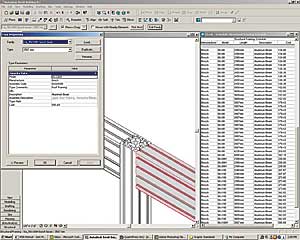Loblolly House: In Stock and Ready to Ship
The supply chain gang
Drawing directly from its book, KTA set about early in the process creating a supply chain of materials and products that could feed the assembly line of elements that would constitute the house. Timberlake considers this the most difficult aspect of the firm's attempt at true prefabrication because, he notes, the "construction industry is so fragmented, with no control of the supply chain and new suppliers starting up every day."
The architects divided the chain between three tiers of suppliers and a final assembler, much in the way automotive companies outsource major components of each car with final assembly at factories throughout the world. In the case of the Loblolly House, Bensonwood-a New Hampshire−based timber-frame-house company-acted as both a supplier and the final assembler. Bensonwood recently completed a quasi-prefab house as part of the Massachusetts Institute of Technology's Open Prototype Initiative, which streamlines a design-build approach for high-quality custom houses with quick construction schedules. Bensonwood, as well as a construction manager, Arena Program Management, collaborated with KTA to devise the specifics of the supply chain for Loblolly.
 |
| The architects developed a comprehensive building information model (BIM) using the Revit software program. The model enabled them to precisely order the aluminum frame (above and below). |
 |
Marilia Rodrigues, a project architect for KTA, helped develop the supply chain, which then fed her work on the virtual model within the Revit software program. Before it became ubiquitous, KTA adopted parametric modeling into its practice after finding inspiration from a 2002 trip the architects took to Boeing's facilities in Everett, Washington. This led to initial development of the Loblolly House on an early version of Revit. KTA's conversion to BIM hasn't been easy; as Timberlake says, "Having learned to draft with a T-square, the hardest part is learning how to work through the fingers and palms of others." Still, both Timberlake and Kieran feel so strongly about the need to evolve their practice, they require BIM to some degree on all projects.
Toward the beginning of the project, the team settled on an extruded aluminum frame structure manufactured by Bosch Rexroth and typically used in factory and temporary structure applications. Knowing the exact specifications of the structure enabled Rodrigues to build a true virtual model with a design tolerance of only a few millimeters, an impossible feat with conventional materials like wood or steel. "With the model, we see the house as existing," Rodrigues says, which then allowed KTA to order finish items and casework directly. "It's amazing how much our industry relies on that final field measurement, which we didn't need."
 |
| The model enabled them embed supply-chain information regarding other materials, such as the exterior cedar siding. |
Bosch never intended its frame system for architectural use, so KTA developed a collection of five connectors that would meet the structural requirements of a three-story house with its requisite dead, live, and wind loads. While the connectors were expensive to develop (KTA is pursuing patents for its designs), the frame system's reliable measured precision of a 1-millimeter tolerance and the fact the frame could be constructed on-site in a few days won the architects' favor. Even with advanced techniques in computer-enabled steel fabrication, only aluminum, with its silicon-based alloy blend, can achieve this precision without the need for shimming in the field-more than offsetting any cost differences. Additionally, the frame system's grooved channels connect to cartridges, windows, and sliding doors through the use of T-blocks (2,100 in all), which screw the house together.
KTA embedded supply-chain information in the Revit model, so a click on any framing element or finish material displays, such as dimensions, material, and supplier-effectively combining design and specifications into one digital locus. The architects converted the model into AutoCAD, which allowed Bensonwood to convert it into its fabrication software, CadWorks.









